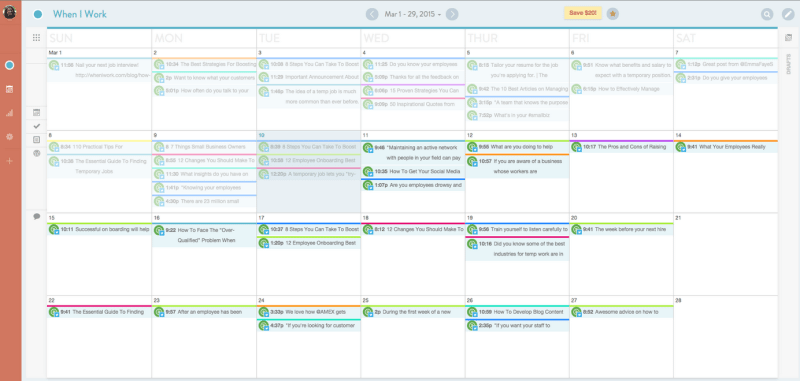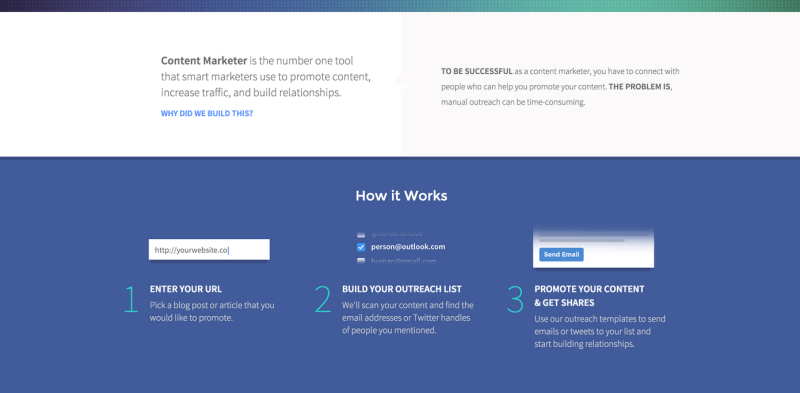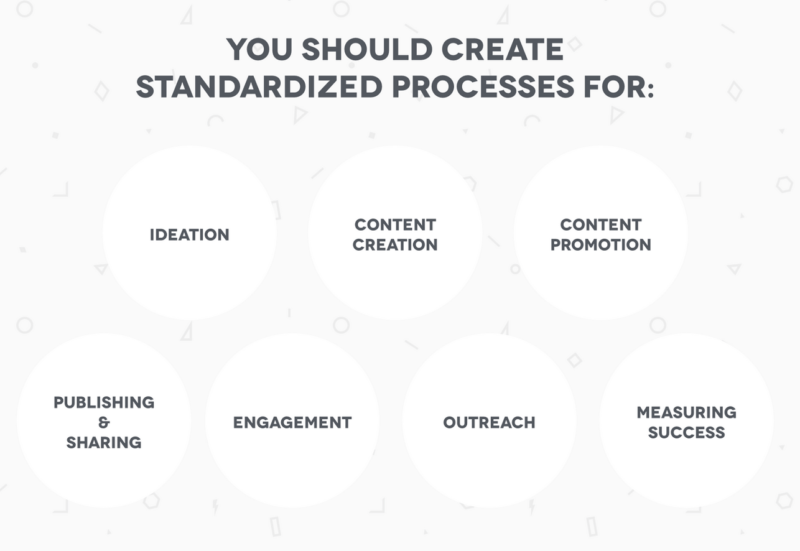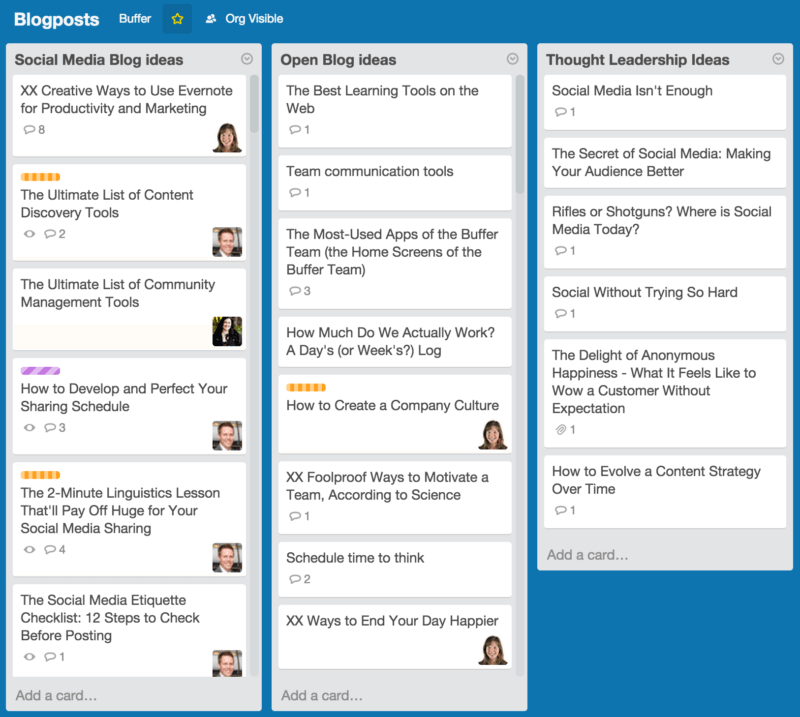37+ Tips and Resources For Building a Fine-Tuned Content Marketing Machine From The Ground Up
Back when I started my career in SEO, content marketing didn’t exist—at least not in the way it exists now.
We used strategies to boost traction and traffic to websites through the creation of great content—it was content marketing before the term even existed. And it worked.
I’ve carried the lessons with me ever since. And I’d love to share them all with you—everything I’ve used to successfully help hundreds of companies benefit from content marketing over the past five years.
Here are 37+ tips and resources you can use to build a fine-tuned content marketing machine from the ground up.

The Key Concepts of Content Marketing
In 2009, I founded a company called Single Grain. It started as a part-time consulting gig but very quickly grew into a powerhouse digital marketing agency. In the early years, we were successful because we were able to help businesses of all sizes–including a few Fortune 500 companies—gain more traction online by implementing what we referred to then as link-building strategies.
Here’s how it worked:
- Search for a particular term or phrase that our clients wanted to rank for
- Find old pieces of content that showed up
- Create better (original) content that our clients could take and publish on their own sites in order to start ranking for the term or phrase
What we found in implementing this strategy over and over again for clients was that well-written, relevant content always gave us the best results. In addition, we found that great content did wonders for building brand reputation, establishing authority, and increasing sales.
Sound familiar?
This is essentially the same tactic that companies and agencies still use to this day in order to gain traction online, only now everyone refers to it as content marketing.
Today, content marketing is an essential part of building and growing a business. It’s one of the best ways to increase traffic, build a community of loyal customers, and move the needle.
How to Build a Content Marketing Machine: 37+ Tips and Resources
The 6 Best Articles for Learning the Basics
The best way to really dive into the world of content marketing is to start reading.
There are a ton of valuable resources online from influencers, experts, and other business owners who all started right where you are now. It’s up to you to take advantage of the free value they offer.
Here are six of my favorite “content marketing 101” articles that you can start with:

1. The Beginner’s Guide To Content Marketing – This KISSmetrics post by Joseph Putman provides readers with a fantastic overview on what content marketing is, why it exists, and how to get the most out of your efforts. The nice thing about this article is that it’s not super lengthy, so only have to spend a few minutes on it before diving into some of the meatier posts I’ve included below.
2. The Complete Guide To Building a Blog Audience – If you have zero experience blogging before, either for yourself personally or for your business, this QuickSprout guide from Neil Patel & Aaron Agius is a great resource to explore. In it, you’ll learn things like how to build your community, the differences between paid and organic search, how to incorporate social media into your blogging efforts, and more.
3. The Ideal Length of Everything Online, Backed by Research – You might be surprised to learn that a lot of research has been done on the ideal length of online content. In this widely popular and overwhelmingly valuable guide by Buffer’s own Kevan Lee, you’ll learn how long your tweets, blog posts, Facebook updates, and subject lines should be in order to be effective.
4. 31 Infographics For Everything Content Marketing – You could spend a lifetime reading through all the articles that exist online about content marketing. But who has time for that? As you probably already know, you can digest information in infographics and visuals a lot easier and faster than you can information in a really meaty and lengthy blog post. If you can’t spend as much time reading up on content marketing as you’d like, skim through this Uberflip resource from Hayley Mullen. It’s a collection of the best infographics on content marketing.
5. How to Build an Audience that Builds Your Business – When you’re ready to start really diving deeper into higher level content marketing topics, check out this resource from the Copyblogger team. It’s a collection of fantastic content marketing guides that will educate you on subjects such as how to do research, how to develop a working strategy, and how to actually promote your content once you’ve created it and published it on your site.
6. The Power of Storytelling: How We Got 300% More People To Read Our Content – When it comes to content marketing, stories rule. You don’t have to take my word for it though. Instead, read through this fantastic case study by Groove CEO Alex Turnbull. In it, he illustrates the importance of storytelling by shedding light on how he used storytelling to grow his blog audience by 300%.
7 Tips for Building Your Team

When it comes to content marketing, your ability to be successful ultimately depends on the team you build.
When I decided to start offering content marketing services at Single Grain, I knew that it meant I would have to hire people who knew more about it than I did. I needed people who were experts—people who were passionate and motivated to continue learning. I felt it was the only way we would be able to actually help the businesses that were reaching out to us for help.
Are you ready to build your content marketing team? If so, follow these tips:
7. Hire someone who knows SEO better than you. SEO plays a big role in content marketing. You need to hire someone who has experience and knowledge in the field who can help you make sure you’re writing about the right things and taking advantage of the right opportunities.
8. Find a solid writer who has marketing experience. This tip is important. You must hire someone—freelance or full-time—who has strong writing abilities. Google doesn’t like lazy or bad copy, and neither do your prospective customers.
9. Make sure you have a data person on your team. There’s a lot of data that can be measured, analyzed, and evaluated in relation to content marketing. You need to have someone on your team who can cut through the noise and find the information that’s going to help you keep making the right moves.
10. Bring a graphic designer on board. In content marketing, visuals are king. Hire someone who can help you create original, compelling visual content that you can use in your blog posts and on social media.
11. Hire a community manager who participates everywhere. In order to build a community of loyal readers, prospects, and customers, you need to hire someone to help you participate on sites like Facebook and Twitter. Find someone with community management experience that you can put in charge of reaching out to and engaging with people online.
12. Put someone in charge of partnership marketing. One of the best ways to grow your blog fast is by working with other partners on content projects. To do this, you need to put someone in charge of partnership marketing—someone who can help you build relationships with other like-minded businesses that would be willing to partner up on blog posts, webinars, infographics, and other types of content.
13. Find an experienced front-end developer. Finally, you need to hire a developer who can help you build squeeze pages, bigger content resources like this Email Marketing Best Practices Guide from Jimmy Daly at Vero, and other front-end marketing projects.
7 Tips to Keep Your Budget In Check
If you don’t have a clear plan in place, it’s pretty easy to spend a lot of money on your content marketing efforts in little to no time at all. When you’re just getting started, it’s important not to let things get out of hand in terms of the money you spend.
To keep your budget in check and make sure you’re putting the right dollars in the right places, use these tips:
14. Take advantage of free trials. You might be hesitant to search for and try content marketing tools and apps because of your limited budget, but keep in mind that a lot of the tools available to you offer free trials.

Take advantage of them and do your best to actually use them. Figure out which tools would be worth your money, and which ones you can pick up at a later time.
15. Do some things yourself first before hiring or outsourcing. In the previous section I talked about the importance of building your team, but it’s really only something you should do once you’re absolutely sure that it’s something worth investing in. Until then, save money by doing some of the work on your own first when possible. It is possible (to an extent) to “fake it until you make it.” There are a lot of helpful, actionable, and easy-to-understand resources out there that you can use to give content marketing a spin on your own first before giving the reins to someone else.
16. Be willing to spend (a little) money on Facebook. It’s important that you take the time to authentically and consistently participate with your community of followers, prospects, and customers on Facebook, but if you really want to build your blogging audience and get the most ROI out of the site, you need to be willing to spend some money creating paid campaigns that help you promote your content. Start with a small daily budget and adjust going forward based on results.
17. Work with college students and interns. Most college students are eager to gain additional experience that they can add to their resume. If your business is relatively new or you’re simply strapped for cash, consider hiring and working with college students or creating internships for content marketing positions. It’ll save you money and give you the opportunity to work with some of the brightest up-and-coming minds in the industry.
18. Build organic relationships as much as possible. Another great way to save money is by building organic relationships with influencers as much as possible (as opposed to putting a lot of money into building and launching expensive advertising and promotion campaigns). Get started by reading this article on the subject from KISSmetrics.
19. Remember that your budget allocation can change month-to-month. Don’t be afraid to make changes to your budget month-by-month. You’ll learn things along the way that will help you make more informed decisions about where and how to spend your content marketing budget.
20. Don’t be cheap. You want to make sure that you don’t let your spending get out of control, but that doesn’t give you a free pass to be cheap. At the end of the day, you’re going to have to spend some money if you want to use content marketing as another way to connect with prospects, build brand awareness, and ultimately grow your business. The trick is to constantly be testing and evaluating ideas in order to determine what tactics are actually worth the money.
6 Content Marketing Tools
Picking the right content marketing tools is almost as important as picking the right team members. The problem is, there are are a TON of tools out there and they aren’t all created equally. So how do you know which ones should you take the time to test out?
Here are six tools that we use on a regular basis to streamline our content marketing efforts at When I Work:
21. Buzzsumo – This is probably my favorite tool to use for ideation and outreach. Buzzsumo makes it incredibly easy to analyze which content performs best for any topic or competitor. You can also use it to see who has shared a specific piece of content and how likely they are to actually engage with people on Twitter. To see what else it can do, check out these use cases.

22. Google Analytics – This tool is a must-have if you’ve made the decision to invest in content marketing. It’s really the only way to get a complete and accurate picture on how the content you publish is performing and be able to make informed decisions about what to publish next.
23. Mailchimp – Email marketing is an important piece of building your community and getting your content in front of new faces. With Mailchimp you can launch an rss email campaign that sends your new posts out to subscribers as soon as you hit publish.
24. CoSchedule – This is my preferred tool for creating content calendars. It’s a great tool because it allows you to work right in WordPress—so you don’t have to leave your blog when it comes time to decide when and how often you want to share the blog content you create.

25. Zemanta – This is the main tool I use for paid content promotion and syndication. Zemanta distributes content across a wide variety of platforms and sites, which helps increase your brand exposure and brings new readers to your site.
26. Content Marketer – This tool that I created (shameless plug) can be used to automate your content promotion efforts. It streamlines the process of finding contact information of influencers that you’ve mentioned in your blog posts, saving you a lot of time and headaches.

7 Tips for Creating a Content Process
Once you have your team, tools, and budget in place, the next thing you’ll want to do is start creating repeatable processes for all your content marketing campaigns and projects. This is an important step, especially when it comes time to start scaling your efforts.

Here are seven tips that will help you be successful:
27. Standardize your ideation process. Ideation is one of the most important steps you need to take when creating content for your website or blog. If your idea is bad, your content will be bad. Build a standardized the process for coming up with your next ideas by including repeatable steps, tools, and tips. Need help getting started? Read what Alex Turnbull at Groove does to come up with great blog ideas week after week.
28. Create a repeatable process for content creation. It’s also important that you take the time to standardize the actual content creation phase itself. In order to be as intentional and purposeful with your content as possible, you have to give yourself time to think and plan. A step-by-step process will make it possible. If you need help getting started, check out this guest blog post from Jennifer Bourn on the CoSchedule blog.
29. Create editorial and social media publishing calendars. When it comes to content marketing and social media marketing, you never want to feel like you’re flying by the seat of your pants. Everything you do needs to be formulaic. That means you can’t just publish blog posts and social media updates when it’s convenient to you. You can add a lot more strategy and thought to your efforts by creating editorial and social media publishing calendars.

Not sure where to start? Read through this comprehensive guide from Buffer’s own Kevan Lee.
30. Create an outline for how you want engagement to happen. Similarly, you should also create a process for engaging with people on your blog and on social media sites like Facebook and Twitter. It makes scaling a lot easier and it makes it possible for you to easily hand the responsibilities over to someone else once you’re ready to hire more people to help you.
31. Put a step-by-step content promotion plan together. Unless you have a clear strategy in place for how you intend to promote each piece of content you create on your blog, you’re not going to see the level of engagement or traffic that you want to see. Putting together a repeatable promotion process can ensure that you’re getting the most out of every piece of content that you publish on your blog. If you need help creating a plan, read through this post I wrote on the subject.
32. Create outreach templates. A big part of the promotion plan you put together should involve manually reaching out to influencers and other people through email who can help you promote your content. Creating and using outreach templates can save you a lot of time and energy during this phase. You can find a ton of great outreach/promotion templates throughout this KISSmetrics post written by Aaron Agius.
33. Design a process for measuring and evaluating success. Finally, you should have a clear process in place that details how to measure and evaluate the overall success of every piece of content you publish. Not sure where to start? Read this post on the SumAll blog written by marketing expert Brian Honigman. In it, he outlines seven metrics you can look for and evaluate in order to measure your content marketing efforts.
7 Tips for Evaluating Success & Scaling Your Efforts
At the end of the day, you can implement every tip and tool that I’ve outlined up to this point in the post and it will mean nothing unless you are willing and able to measure, evaluate, and scale your efforts. A lot of people are intimidated by numbers, analytics, charts, and growth in general, but you don’t have to be.
Here are seven tips to help you evaluate and scale:
34. Set KPIs and goals ahead of time. You can’t measure what you don’t track, and you can’t evaluate whether or not goals have been met if you never take the time to set up clear goals or KPIs in the first place. Think about what you want to get out of the time, energy, and money you put into content marketing for your business (ex. more traffic, more conversions, more social engagement). Decide how you’re going to determine what can be called a success and what can’t.
35. Become obsessed with data or hire someone who can be for you. For content marketing to work for your business, you have to be obsessed with data. It’s the only way you’ll be able to benefit from your efforts and ultimately scale. If you’re just not a numbers guy (or girl), hire someone who is and put them in charge of collecting, interpreting, and reporting to you on relevant data.
36. Don’t be afraid to give up on something that isn’t working. In marketing and in business, you have to be comfortable with giving something up that isn’t working. You can’t take things so personal that you end up making the wrong decisions or keeping an idea alive for too long. You have to try to be as objective as possible. If you put a lot of time and energy into something and the needle never moved, don’t be afraid to drop it and move on to something else. It’s OK if your idea didn’t work—that’s what testing new tactics and ideas is all about.
37. Don’t fall into the “vanity metrics only” trap. It can be tempting to hold vanity metrics such as “likes,” “pageviews,” or “shares” above everything else when you’re participating on social media or regularly publishing content on your blog, but try not to ignore other “less sexy” data when it comes time to deciding whether to call something a success or not. Try to get the whole picture and think about the goals you originally set before you started working on your project. For more on this subject, read through this post from Lars Lofgren at KISSmetrics.
38. As you scale, don’t forget about quality. It’s so important that you don’t sacrifice quality for the sake of scaling as you continue to build your content marketing machine. I can’t stress this enough! Your followers, prospects, and customers want only the very best content from you, and that’s exactly what they deserve from you. Give them content that helps them, that keeps them talking about you, and that keeps them coming back for more.
39. Use tools to streamline your efforts. I touched on this a bit above, but it’s worth mentioning again. There are a ton of excellent, time-saving tools out there that can be used when it comes time to scale your efforts. They won’t all be right for you and your goals, but you won’t know until you try them for yourself.
40. Be open to trying new things. Things change fast in the world of content marketing. What worked yesterday might not work today. What works tomorrow might not work a year from now. In order to stay ahead of the game, you have to be open to trying new things. If you read about a new tactic that worked for someone else, decide if you want to try it for yourself. If something that worked well for you in the past but it doesn’t seem to be working well for you anymore, start hunting for new strategies and tactics to try. Talk to business partners, read blog posts, participate in forums like Inbound.org, and find something that you can test.
Over to you
What other tips, tools, or resources would you add to this list? I’d love to get your thoughts. Leave a comment for me below, or reach out to me directly on Twitter—I’m @SujanPatel.
Image sources: UnSplash, IconFinder
Try Buffer for free
180,000+ creators, small businesses, and marketers use Buffer to grow their audiences every month.
Related Articles

Stop chasing the tail-end of Instagram audio trends — here are the latest trending songs on Instagram in July 2025.

We pored over millions of posts on Instagram, Facebook, Twitter, YouTube, TikTok, and LinkedIn to pinpoint when the best-performing content was published.

Learn how to leverage AI social media content creation tools and save valuable time in your social media marketing efforts.